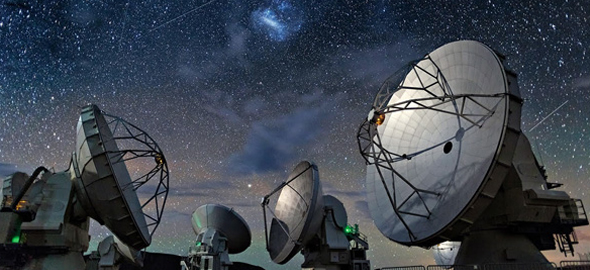Chileans design "an artificial eye" to look at the stars
Thursday, November 22, 2019
.jpg) David Monasterio, Electrical Engineer and
PhD student of the Millimeter Wave Laboratory of the FCFM of the University of Chile |
A team of engineers prepares equipment for the new generation of telescopes. The results were published in the scientific journal “Transactions on Terahertz Science and Technology”.
The interdisciplinary team, which has the support of the Center for Excellence in Astrophysics and Associated Technologies CATA, built a mini-receiver equivalent to the size of a human eye that could capture the images of the universe several tens of times faster than the technology of the contemporary astronomy radio.
“We have worked on a receiver, which is a device that receives the signal from the observed object, just as the human eye does, but in a very compact way. In this case, placing dozens of small receivers in the place where there was only one before ”, explains David Monasterio, engineer and PhD student of the Millimeter Wave Laboratory of the Faculty of Physical and Mathematical Sciences of Universidad de Chile.
More than meet the eyes
Radio telescopes capture frequencies that circulate through space and that generate bodies in the cosmos, such as stars or nebulas, which are not visible to the human eye. “What we are looking for is to improve these receivers, to observe several objects simultaneously and also to improve the image quality. To achieve this, the miniaturization process was a key aspect and that is exactly what we did, ”adds the researcher at CATA Astrophysics Center.
After this publication, the bandwidth of the receiver will be extended, in other words, it will increase the amount of colors that the radio telescope will see and also will test other architectures and construction designs.
For Monasterio, one of the highlights of the research is its versatility “No other university in Chile have developed integrated microwave circuits from scratch, that is, an element of great sophistication in a very small physical area, which is one of the key components for the design of receptors”, express the scientist.
Additionally, this type of technology could subsequently be used beyond the limits of astronomy, going to fields such as: space communications, atmospheric mapping and military applications.
Dr. Claudio Jarufe and Nicolás Reyes, as well as Patricio Mena and Leonardo Bronfman, both academics of the Faculty of Physical and Mathematical Sciences of Universidad de Chile, also participated in the research.
To see the original publication check the following web address https://ieeexplore.ieee.org/document/8815734
 |




